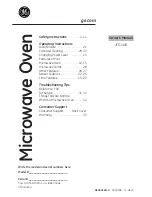
33
■
%
Top/bottom heating
■
3
Hot air
Always preheat the oven.
Baking tips
Roasting and grilling
About the tables
The temperature and roasting time depend on the type and
amount of food being cooked. This is why temperature ranges
are given in the tables. Begin with the lower temperature and, if
necessary, use a higher setting the next time,
For more information, see the section entitled
Tips for grilling
and roasting
which follows the tables.
Ovenware
You may use any heat
resistant ovenware which is suitable for
use in a microwave. Metal roasting dishes are not suitable for
roasting with microwaves.
The ovenware can become very hot. Use oven gloves to take
the ovenware out of the oven.
Place hot glass ovenware on a dry kitchen towel after they have
been removed from the oven. The glass could crack if placed
on a cold or wet surface.
Tips for roasting
Use a deep roasting dish for roasting meat and poultry.
Check that your ovenware fits in the cooking compartment. It
should not be too big.
Meat:
Cover approx. two thirds of the ovenware base with liquid. Add
a little more liquid for pot roasts. Turn pieces of meat halfway
through the cooking time. When the roast is ready, turn off the
oven and allow it to rest for an additional 10 minutes. This
allows better distribution of the meat juices.
Poultry:
Turn the pieces of meat after
Z
of the cooking time has
elapsed.
Tips for grilling
Notes
■
Always keep the oven door closed when grilling and do not
preheat.
Bread and rolls
Accessories
Level
Type of
heating
Temperature °C
Cooking time in
minutes
Yeast bread with 1 kg of flour
Universal pan
2
%
270
+ 170
10
15-25
Sourdough bread with 1.2 kg flour
Universal pan
2
%
270
+ 170
10
40-50
Flatbread
Universal pan
2
3
220-240
15-20
Bread rolls
Universal pan
2
%
200-220
20-30
Rolls made with sweet yeast dough
Universal pan
2
%
190-210
15-25
You want to bake according to your own
recipe.
Use similar items in the baking tables as a guide.
Use baking tins made of silicone, glass,
plastic or ceramic materials.
The baking tin must be heat-resistant up to 250 °C. Cakes in these baking tins will be
less brown. When using the microwave, the cooking time will be shorter than the time
shown in the table.
How to establish whether sponge cake is
baked through.
Approximately 10 minutes before the end of the baking time specified in the recipe,
poke the cake with a cocktail stick at its highest point. If the cocktail stick comes out
clean, the cake is ready.
The cake collapses.
Use less liquid next time or set the oven temperature 10 degrees lower and extend
the baking time. Observe the specified mixing times in the recipe.
The cake has risen in the middle but is
lower around the edge.
Only grease the base of the springform cake tin. After baking, loosen the cake care-
fully with a knife.
The cake is too dark.
Select a lower temperature and bake the cake for a little longer.
The cake is too dry.
When it is done, make small holes in the cake using a toothpick. Then drizzle fruit
juice or an alcoholic beverage over it. Next time, select a temperature 10 degrees
higher and reduce the baking time.
The bread or cake (e.g. cheesecake) looks
good, but is soggy on the inside (sticky,
streaked with water).
Use slightly less fluid next time and bake for slightly longer at a lower temperature.
When baking cakes with a moist topping, bake the base first, cover with almonds or
bread crumbs and then add the topping. Please follow the recipe and follow the bak-
ing times.
The cake cannot be turned out of the dish
when it is turned upside down.
After baking, allow the cake to cool for a further 5 to 10 minutes, then it will be easier
to turn out of the tin. If it still sticks, carefully loosen the cake around the edges using
a knife. Turn the cake tin upside down again and cover it several times with a cold,
wet cloth. Next time, grease the tin well and sprinkle some bread crumbs into it.
You have measured the temperature of the
oven using your own meat thermometer
and found there is a discrepancy.
The oven temperature is measured by the manufacturer after a specified period of
time using a test rack in the centre of the cooking compartment. Ovenware and
accessories affect the temperature measurement, so there will always be some dis-
crepancy when you measure the temperature yourself.
Sparks are generated between the tin and
the wire rack.
Check that the tin is clean on the outside. Change the position of the tin in the cook-
ing compartment. If this does not help, continue baking but without the microwave.
The baking time will then be longer.












































